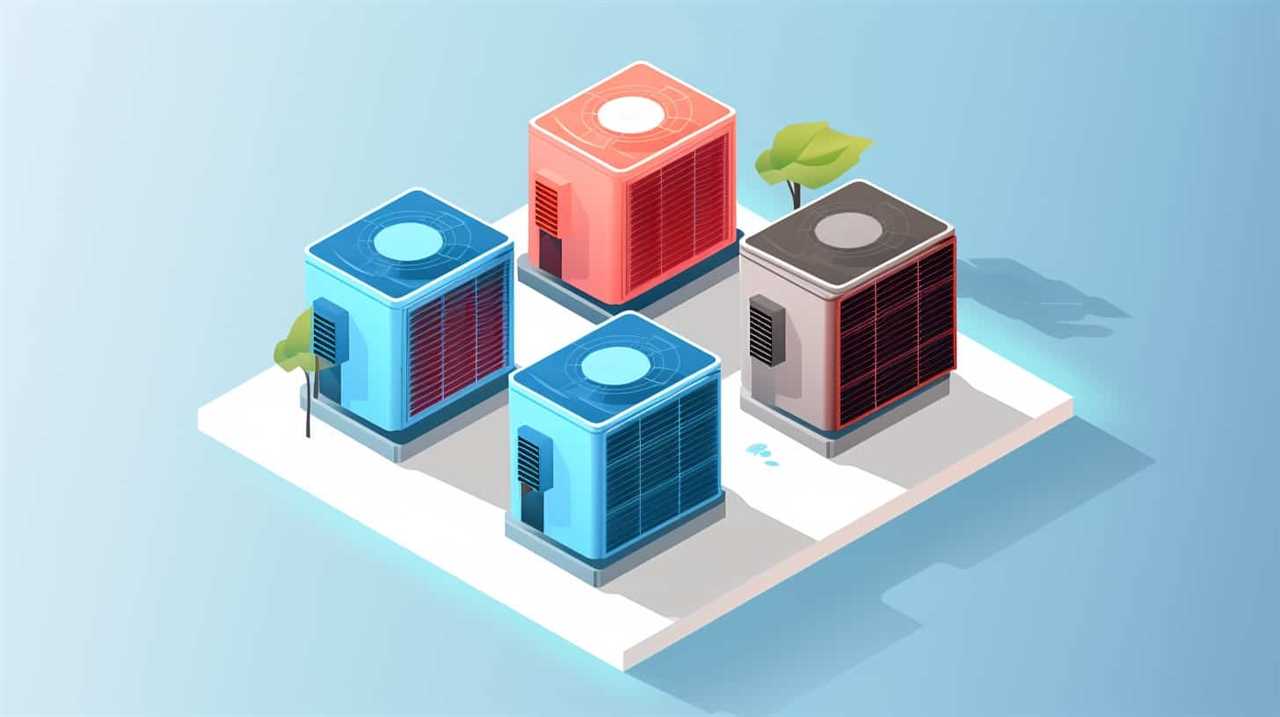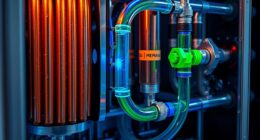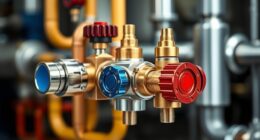Are you fed up with constantly paying steep energy bills? Don’t worry, we have a solution for you! In this article, we will explain in detail the importance of heat pump energy efficiency ratings.
We’ll explain how these ratings are calculated, explore the important factors that affect them, and compare different heat pump models.
Plus, we’ll share tips on how to improve your heat pump’s energy efficiency. Get ready to make an informed decision and save some serious money!
Key Takeaways
- Energy efficiency ratings for heat pumps have a significant impact on cost, energy savings, and environmental impact.
- The key metrics used to calculate energy efficiency ratings for heat pumps include the Coefficient of Performance (COP), Heating Seasonal Performance Factor (HSPF), Energy Efficiency Ratio (EER), Annual Fuel Utilization Efficiency (AFUE), and Seasonal Energy Efficiency Ratio (SEER).
- SEER ratings specifically measure the cooling efficiency of heat pumps and range from around 13 to 25, while HSPF ratings focus on heating efficiency and range from around 7 to 13.
- Factors such as climate, system size, insulation levels, and installation conditions should be considered when choosing the right SEER rating for optimal energy efficiency and comfort.
The Importance of Energy Efficiency Ratings for Heat Pumps
We believe that understanding the importance of energy efficiency ratings for heat pumps is crucial. Energy efficiency ratings not only impact the cost of heat pumps, but also have significant environmental implications.

When it comes to the cost of energy efficient heat pumps, higher efficiency ratings can result in substantial savings on monthly energy bills. Heat pumps with higher efficiency ratings require less energy to provide the same level of heating or cooling, leading to lower operating costs over time.
Additionally, energy efficient heat pumps have a reduced environmental impact. By consuming less energy, they contribute to a decrease in greenhouse gas emissions and help combat climate change.
Investing in energy efficient heat pumps not only benefits homeowners financially, but also promotes a sustainable and eco-friendly future.
How Energy Efficiency Ratings Are Calculated for Heat Pumps
Calculating energy efficiency ratings for heat pumps involves considering various factors and measuring their performance. To determine the efficiency of a heat pump, experts conduct energy consumption analysis by taking into account the following:

-
Coefficient of Performance (COP): This ratio measures the heat pump’s ability to transfer heat relative to the amount of energy it consumes.
-
Heating Seasonal Performance Factor (HSPF): HSPF calculates the average heating efficiency of a heat pump over an entire heating season.
-
Energy Efficiency Ratio (EER): EER determines the cooling efficiency of a heat pump by dividing the cooling capacity by the power input.
-
Annual Fuel Utilization Efficiency (AFUE): AFUE measures the efficiency of a heat pump’s heating process, including the combustion of fuel.

-
Seasonal Energy Efficiency Ratio (SEER): SEER evaluates the cooling efficiency of a heat pump over a cooling season.
Understanding how these efficiency ratings are calculated is essential in choosing the right heat pump for your needs. Now, let’s delve into the details of SEER ratings for heat pumps.
Understanding SEER Ratings for Heat Pumps
When it comes to understanding SEER ratings for heat pumps, there are a few key points to consider.
First, it’s important to understand the difference between SEER and HSPF ratings, as they measure different aspects of a heat pump’s efficiency.

Factors that can affect SEER ratings include climate, system size, and insulation levels.
Lastly, choosing the right SEER rating for your specific needs and budget is crucial to ensure optimal energy efficiency and comfort.
SEER Vs. HSPF
In comparing SEER and HSPF ratings for heat pumps, we need to understand the differences and how they impact energy efficiency.
SEER, or Seasonal Energy Efficiency Ratio, measures the cooling efficiency of a heat pump, while HSPF, or Heating Seasonal Performance Factor, measures its heating efficiency.

Here is a breakdown of the key differences between SEER and HSPF:
- SEER focuses on cooling efficiency, while HSPF focuses on heating efficiency.
- SEER measures the amount of cooling produced per unit of energy consumed, while HSPF measures the amount of heat produced per unit of energy consumed.
- SEER ratings range from around 13 to 25, while HSPF ratings range from around 7 to 13.
- Higher SEER and HSPF ratings indicate greater energy efficiency.
- When comparing heat pumps, it’s important to consider both SEER and HSPF ratings for an accurate efficiency comparison.
Understanding the differences between SEER and HSPF ratings is crucial for a comprehensive performance analysis of heat pumps. By considering both cooling and heating efficiency, consumers can make informed decisions about energy-efficient heating and cooling solutions.
Factors Affecting SEER
One factor to consider when evaluating SEER ratings for heat pumps is the climate in which the heat pump will be operating. The climate can have a significant impact on the efficiency and performance of the heat pump.
In hotter climates, where the cooling demand is higher, a higher SEER rating is recommended to ensure optimal energy efficiency. On the other hand, in colder climates, where heating demand is higher, the HSPF rating becomes more important.

Additionally, factors affecting the installation of the heat pump can also impact its SEER rating. Proper sizing and installation of the heat pump, as well as adequate insulation and sealing, can greatly affect the system’s overall efficiency.
It’s crucial to consider these factors to ensure that the chosen heat pump is suitable for the specific climate and installation conditions.
Choosing the Right SEER
Our primary goal is to choose the SEER rating that best suits our needs and budget. When selecting a SEER rating for our heat pump, we need to consider several factors:
-
Energy savings: A higher SEER rating indicates greater energy efficiency, leading to potential long-term savings on utility bills.

-
Cost effectiveness: While higher SEER ratings offer better energy savings, they may also come with a higher initial purchase and installation cost. We need to find the right balance between energy efficiency and affordability.
-
Climate: The climate we live in plays a crucial role in determining the ideal SEER rating. Hotter climates may benefit from higher SEER ratings, while milder climates may not require the highest rating.
-
Usage patterns: Our usage patterns, such as the frequency and duration of heating and cooling, should also be considered. If we use our heat pump frequently, a higher SEER rating may be more beneficial.
-
Rebates and incentives: It’s important to research any available rebates or incentives that may be offered for higher SEER-rated heat pumps. These can help offset the initial investment cost and increase cost effectiveness in the long run.

Exploring HSPF Ratings for Heat Pumps
Let’s delve into the HSPF ratings for heat pumps to gain a better understanding of their energy efficiency. HSPF, or Heating Seasonal Performance Factor, measures the efficiency of a heat pump’s heating mode. It takes into account both the electrical input and heat output over an entire heating season. The higher the HSPF rating, the more efficient the heat pump is at providing heat.
Advancements in HSPF technology have led to higher efficiency ratings, pushing the limits of what heat pumps can achieve. These advancements include improvements in compressor technology, heat exchanger design, and overall system optimization.
To help visualize the range of HSPF ratings, here is a table showcasing different HSPF values and their corresponding efficiency levels:
| HSPF Rating | Efficiency Level |
|---|---|
| 6.0 – 7.0 | Standard |
| 7.5 – 8.5 | High Efficiency |
| 9.0 and above | Ultra High Efficiency |
Factors That Affect Heat Pump Energy Efficiency Ratings
Exploring the factors that affect heat pump energy efficiency ratings can help us make informed decisions when selecting a heat pump for optimal performance. There are several key factors that can impact the efficiency of a heat pump, including:

-
Climate: The climate in which the heat pump operates plays a significant role in its efficiency. Heat pumps work by transferring heat from one place to another, so extreme temperatures can affect their ability to efficiently heat or cool a space.
-
Insulation: The level of insulation in a building can greatly impact the energy efficiency of a heat pump. Well-insulated spaces retain heat or cool air better, reducing the workload on the heat pump.
-
Size and capacity: The size and capacity of the heat pump must be properly matched to the space it’s intended to heat or cool. An undersized or oversized unit can lead to reduced efficiency.
-
Maintenance: Regular maintenance, such as cleaning and servicing the heat pump, can help maintain its efficiency over time.

-
Technology and features: Advances in heat pump technology, such as variable-speed compressors and smart thermostats, can improve energy efficiency.
Understanding these factors can guide us in selecting a heat pump that will perform optimally in our specific climate and space.
In the next section, we’ll discuss how to compare energy efficiency ratings for different heat pump models.
Comparing Energy Efficiency Ratings for Different Heat Pump Models
When comparing energy efficiency ratings for different heat pump models, it’s important to consider their performance and cost-effectiveness.
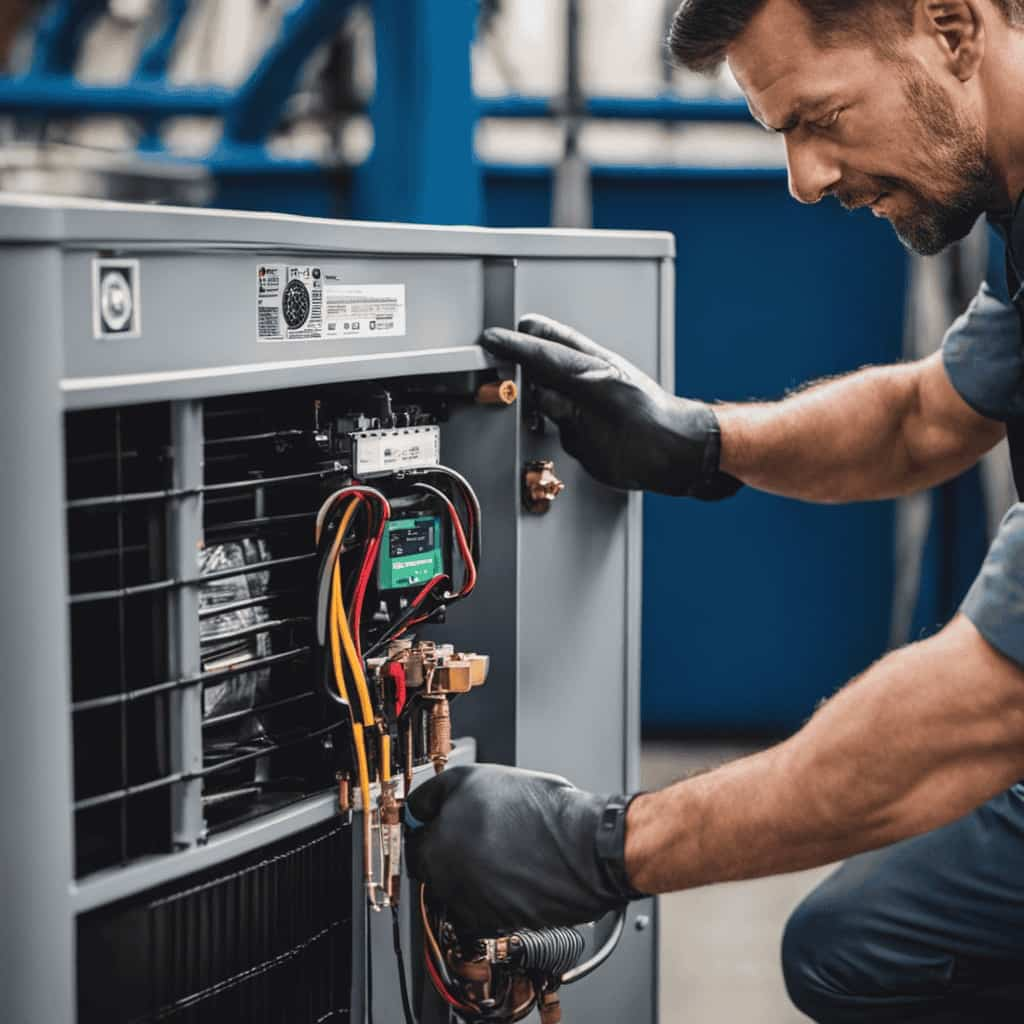
To compare performance, you should look at the unit’s Seasonal Energy Efficiency Ratio (SEER) and Heating Seasonal Performance Factor (HSPF) ratings. SEER measures the cooling efficiency, while HSPF measures the heating efficiency of the heat pump. The higher the SEER and HSPF ratings, the more energy efficient the heat pump is.
Additionally, consider the energy savings that each model offers. Look for heat pumps that have Energy Star certification, as they typically provide significant energy savings compared to non-certified models.
It’s also important to factor in the initial cost of the unit and the potential long-term energy savings it can provide.
The Benefits of Investing in a High-Efficiency Heat Pump
Investing in a high-efficiency heat pump offers numerous benefits for homeowners. Here are the advantages of choosing a high-efficiency heat pump:
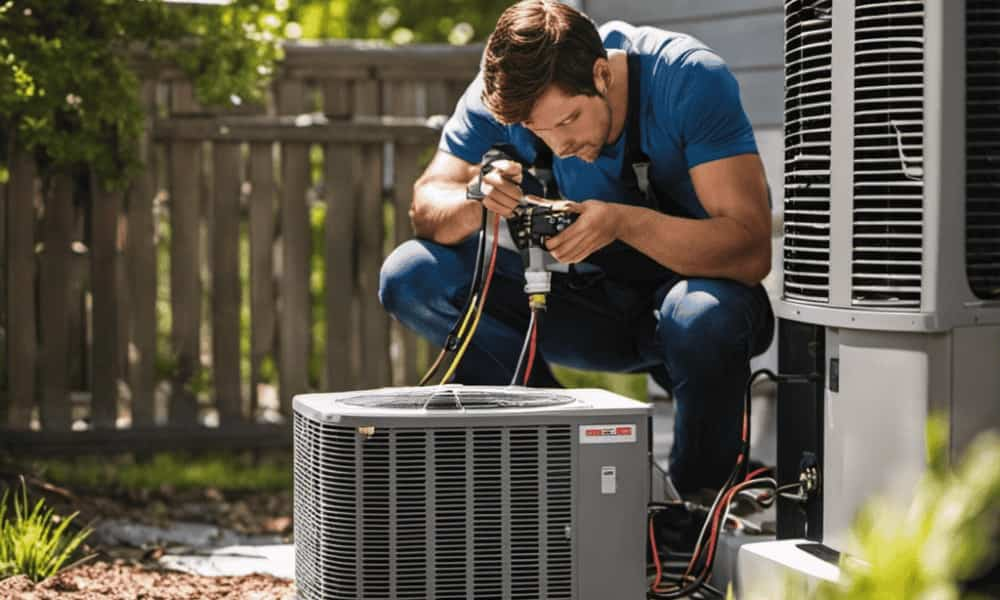
-
Energy savings: High-efficiency heat pumps are designed to consume less energy compared to standard models. This leads to lower utility bills and long-term cost savings.
-
Environmental friendliness: High-efficiency heat pumps use less electricity, which reduces greenhouse gas emissions and helps to protect the environment.
-
Enhanced comfort: High-efficiency heat pumps provide consistent heating and cooling throughout the year, ensuring a comfortable indoor environment.
-
Improved indoor air quality: High-efficiency heat pumps have advanced filtration systems that remove dust, allergens, and pollutants from the air, improving the overall air quality in your home.

-
Increased home value: Installing a high-efficiency heat pump not only improves your home’s energy efficiency but also adds value to your property, making it more attractive to potential buyers in the future.
Investing in a high-efficiency heat pump is a smart choice that offers a range of benefits, including energy savings, environmental friendliness, enhanced comfort, improved indoor air quality, and increased home value.
Tips for Improving the Energy Efficiency of Your Heat Pump
When it comes to improving the energy efficiency of your heat pump, there are a few key points to keep in mind.
First, optimizing the temperature settings can make a significant difference in energy consumption. By setting the temperature a few degrees lower in the winter and a few degrees higher in the summer, you can reduce the workload on your heat pump.

Additionally, regular maintenance practices such as cleaning or replacing air filters, clearing debris around the outdoor unit, and scheduling professional inspections can help ensure that your heat pump operates at its highest efficiency level.
Optimal Temperature Settings
To maximize our heat pump’s energy efficiency, we should regularly adjust the temperature settings. Here are some energy-saving tips regarding the optimal temperature range for your heat pump:
-
Set the thermostat to the recommended range of 18-20°C (65-68°F) during the heating season. This ensures comfort while minimizing energy consumption.
-
Lower the temperature when you’re away from home or asleep. Dropping it by 7-10°F (4-6°C) for 8 hours a day can result in significant energy savings.

-
Avoid setting the thermostat too high during the cooling season. Aim for a temperature range of 23-25°C (74-78°F) to balance comfort and efficiency.
-
Utilize programmable thermostats to automate temperature adjustments based on your schedule. This prevents unnecessary energy usage when you’re not at home.
-
Take advantage of the heat pump’s ability to provide both heating and cooling. Use it for both seasons to optimize energy efficiency.
By following these tips, you can improve the energy efficiency of your heat pump and reduce your energy costs.

Now let’s move on to discussing regular maintenance practices.
Regular Maintenance Practices
To ensure optimal performance and energy efficiency of our heat pump, we should regularly maintain and inspect its components. Following a regular maintenance checklist can help identify any issues and ensure that our heat pump is running efficiently.
Firstly, we should clean or replace the air filters every one to three months to prevent dust and debris buildup.
Secondly, we should clean the outdoor unit regularly to remove any dirt or leaves that may obstruct airflow.

Additionally, it’s important to schedule professional maintenance at least once a year to inspect the refrigerant levels, electrical connections, and other components.
By neglecting regular maintenance, we risk common maintenance mistakes such as reduced efficiency, increased energy consumption, and potential breakdowns.
Therefore, following a regular maintenance routine is crucial for improving the energy efficiency of our heat pump and ensuring its long-term performance.
Understanding Energy Efficiency Labels for Heat Pumps
We often encounter energy efficiency labels for heat pumps to guide our purchasing decisions. These labels provide important information about the energy-saving capabilities of the heat pump and help us choose the most efficient option for our needs. Here are five key items to look for on energy efficiency labels:

- Seasonal Energy Efficiency Ratio (SEER): This rating measures the cooling efficiency of the heat pump during the cooling season.
- Heating Seasonal Performance Factor (HSPF): This rating measures the heating efficiency of the heat pump during the heating season.
- Energy Star Certification: This label indicates that the heat pump meets strict energy efficiency guidelines set by the Environmental Protection Agency.
- Energy Efficiency Ratio (EER): This rating measures the cooling efficiency of the heat pump at a specific outdoor temperature.
- Coefficient of Performance (COP): This rating measures the heating efficiency of the heat pump at a specific outdoor temperature.
Frequently Asked Questions
Are There Any Government Incentives or Rebates Available for Purchasing a High-Efficiency Heat Pump?
Yes, there are government incentives and rebates available for purchasing high-efficiency heat pumps. These incentives aim to encourage the adoption of energy-efficient technologies and can help offset the initial costs of purchasing and installing a high-efficiency heat pump.
How Does the Size of My Home or Building Affect the Energy Efficiency of a Heat Pump?
Considering the size of our home or building is crucial when determining the energy efficiency of a heat pump. Sizing considerations and the impact of insulation play a significant role in maximizing the heat pump’s performance and reducing energy consumption.
Can I Use a Heat Pump as My Primary Heating and Cooling System?
Yes, we can use a heat pump as our primary heating and cooling system. In a cold climate, heat pumps provide efficient heating and cooling, saving energy and reducing costs compared to traditional HVAC systems.
Are There Any Maintenance Tasks I Can Perform to Improve the Energy Efficiency of My Heat Pump?
We can improve the energy efficiency of our heat pump by performing regular maintenance tasks. Simple maintenance tips such as cleaning or replacing air filters, checking refrigerant levels, and ensuring proper airflow can help save energy and optimize performance.

Are There Any Additional Features or Technologies That Can Further Enhance the Energy Efficiency of a Heat Pump?
Smart technology and advanced insulation are additional features and technologies that can further enhance the energy efficiency of a heat pump. These innovations optimize performance, reduce energy consumption, and provide greater control and convenience for users.
Conclusion
In conclusion, understanding heat pump energy efficiency ratings is crucial for making informed decisions when it comes to choosing the right heat pump for your needs.
While it may seem counterintuitive, investing in a high-efficiency heat pump can actually lead to significant energy savings in the long run.
So, don’t be fooled by the irony of prioritizing energy efficiency when it comes to staying warm or cool – it’s a smart choice that will benefit both your wallet and the environment.





